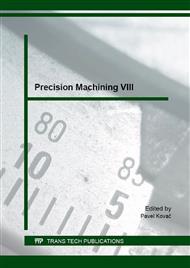p.108
p.114
p.119
p.125
p.131
p.137
p.143
p.149
p.155
Influence of Technological Parameters on Surface Quality of Injection-Molded Parts
Abstract:
In the most cases manufacturing of injection mold and its cavities comprise more than half of the total production time. Very fine finishing operations can increase production time and cost of injection mold. Appropriate choice of finishing operations and injection technological parameters can reduce price of injection mold production, shorten production time and thus lower price of small and thin injection molded parts. Tool material X38CrMoV5-1, used for cavity in injection mold, was finished by fine turning, grinding, lapping and polishing with different technological conditions to achieve various surface roughness. The main aim of this research is to find an influence of surface quality of cavity and injection technological parameters on the surface quality of injection molded parts.
Info:
Periodical:
Pages:
131-136
Citation:
Online since:
February 2016
Authors:
Price:
Сopyright:
© 2016 Trans Tech Publications Ltd. All Rights Reserved
Share:
Citation:


